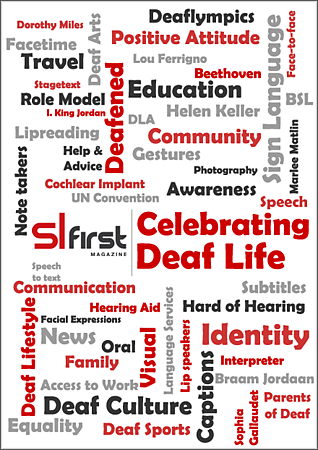Language & Communication4th January 2014
Cartooning
Cartooning has a long established history but they have their limitations for deaf topics!

"Quick, quick, what's the sign for SHARK!"
My name is Jim. I am now Hard of Hearing and I am the guy who is trying to raise a smile from you in the SLFirst magazine by creating some humorous cartoons.
At Art College I specialised in Book Illustration and Graphic Design so it was an easy transition into producing cartoons. My first cartoons were done when I was in the R.A.F. and later, when living in Essex, I played rugby for a local club and regularly drew cartoons for the club magazine and painted a suitable mural over the bar.
 Rugby players are "naturals" when it comes to creating caricatures. On almost every rugby field you can spot a "typical" rugby type, so much so in fact some over emphasis on features are hardly necessary.
Rugby players are "naturals" when it comes to creating caricatures. On almost every rugby field you can spot a "typical" rugby type, so much so in fact some over emphasis on features are hardly necessary.  However, creating humorous drawings relating to deafness is an entirely different matter. Deafness is all about "sound", or lack of it and the big problem for an illustrator is that sound is invisible! Now how do you create a picture about an invisible subject? This is my constant headache. A good cartoon should have as small a caption as possible, better still no caption at all. Many ideas have been offered to me but nearly all need a lengthy introduction.
However, creating humorous drawings relating to deafness is an entirely different matter. Deafness is all about "sound", or lack of it and the big problem for an illustrator is that sound is invisible! Now how do you create a picture about an invisible subject? This is my constant headache. A good cartoon should have as small a caption as possible, better still no caption at all. Many ideas have been offered to me but nearly all need a lengthy introduction.
I should explain that I am also deaf so I have empathy with the problems concerned with deafness. I am lucky in that I am not totally deaf, I have hearing aids which allow me to live a fairly normal life as far as sound is concerned.  Without my aids I am very deaf and I can understand the frustrations caused with this lack of communication. I try to see the funny side of incidents but most are concerned with asking the speaker to repeat what was said; sometimes resulting in strange conclusions and these I try to use but depicting someone shouting at a deaf person has limitations!
Without my aids I am very deaf and I can understand the frustrations caused with this lack of communication. I try to see the funny side of incidents but most are concerned with asking the speaker to repeat what was said; sometimes resulting in strange conclusions and these I try to use but depicting someone shouting at a deaf person has limitations!
With regard to hearing aids, to keep fit I swim every morning before breakfast and a few years ago I had a very serious ear infection which necessitated hospital treatment. The cause given was that putting my hearing aids back in immediately after swimming stopped the small amounts of moisture left in the ears from drying out completely. The hearing aids get very warm at times and this allowed the bacteria in the moisture to "cook" nicely and cause infection. Now I make sure that while I have breakfast I do not wear my aids and have had no further problems.
Ah well, time to get back to the drawing board.
If you enjoy the SLFirst Magazine and want to be notified when new articles are published, like us on facebook
Cartoons
The name “Cartoon” originally had no connection with humour. In the time of the Rennaissance when Leonardo Da Vinci, Michaelangelo and Raphael were painting the Sistine Chapel a "cartoon" was a full-scale finished drawing of the painting to be executed.
The drawing would be done on some thin material – linen perhaps – the drawn lines would be perforated with "pin-pricks" by the artist's apprentices who would then fasten the drawing over the wall or canvas to be painted. The students then patted powdered chalk on the pin-holes so that when the cartoon was removed an outline of the design would be left on the surface. The chalk lines were then re-drawn carefully ready for the Master to start painting. Jump ahead to the ninteenth century when the printing of books and magazines became easier and popular and illustrators drew their designs on to blocks of wood which in turn were cut or engraved by specialist craftsmen. The blocks were then fitted in with the text to be printed.
The term cartoon was once again in fairly common use as the artist drew on the wood blocks. However, this was a time of cheap newspapers, booklets and magazines and satirical drawings about the Government and politics became popular and with the advent of the magazine "Punch", even wider kinds of humour appeared. The sketches or "cartoons" became associated with funny drawings and so it is the word we use today for comic pictures.
Article by E.W. James
posted in Community / Language & Communication
4th January 2014





